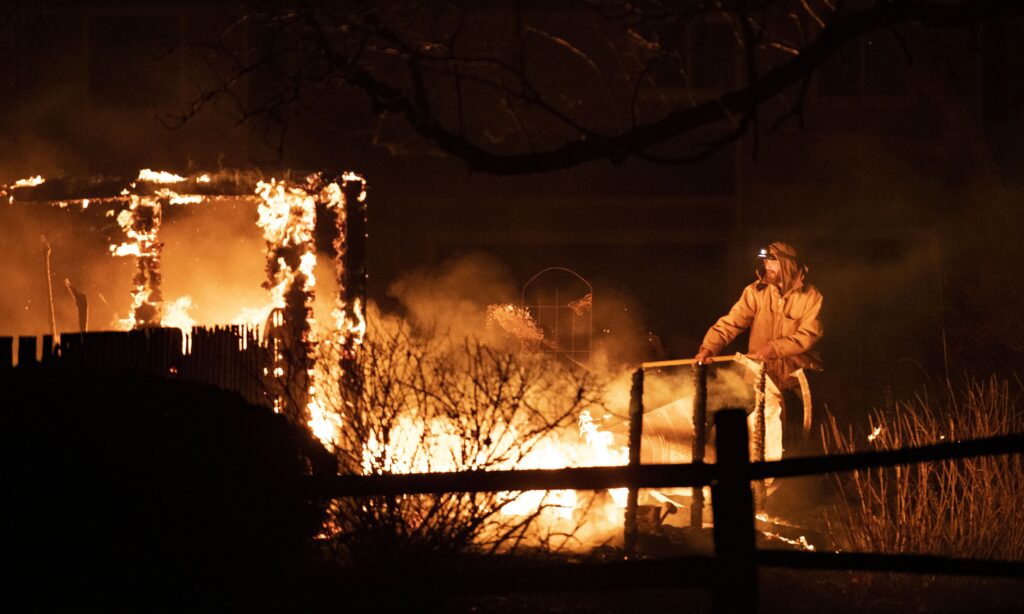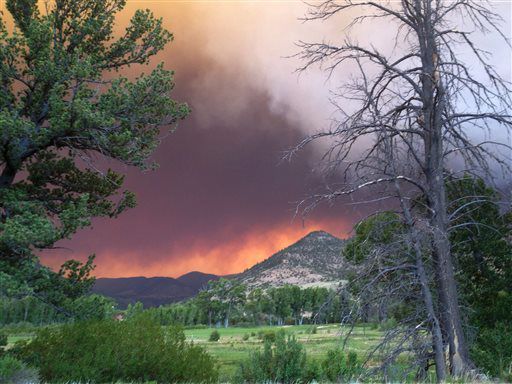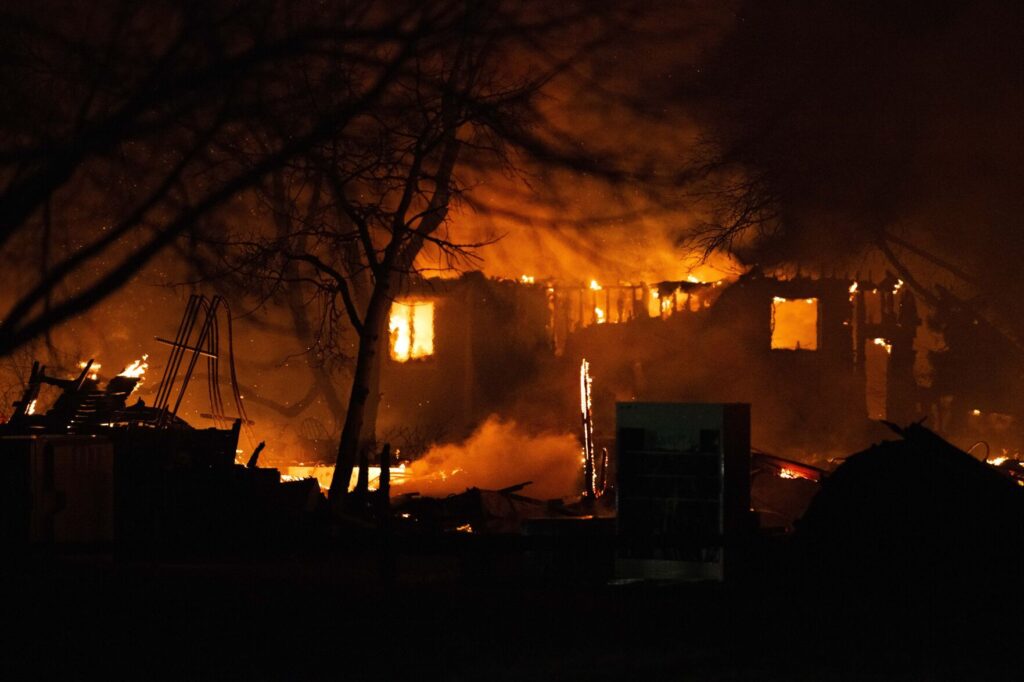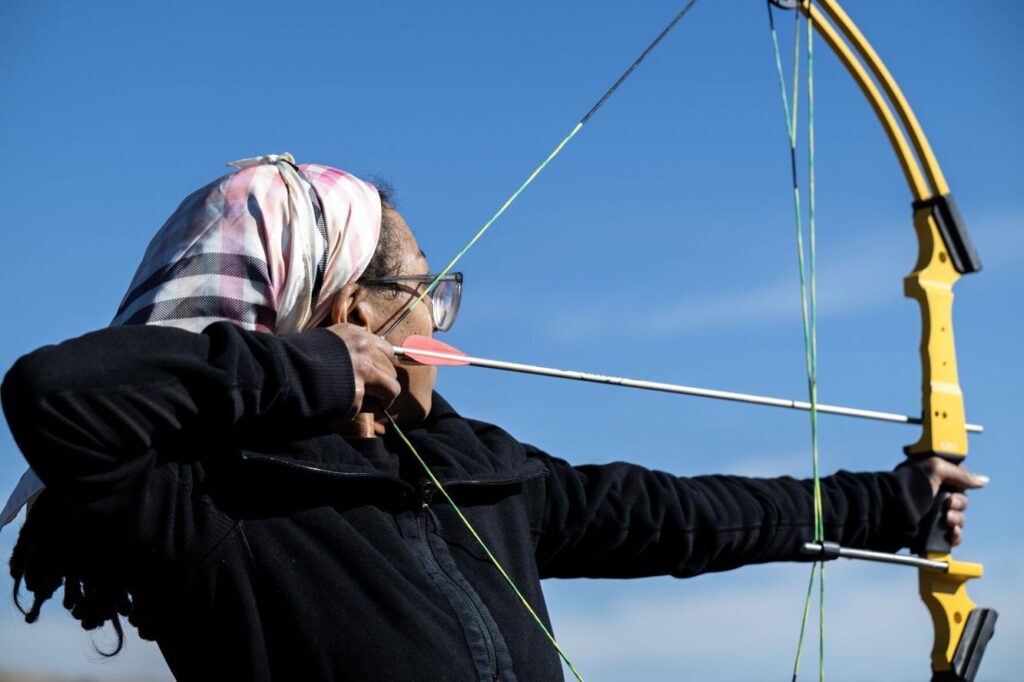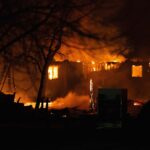The Lee fire’s effects on Colorado ranchers reaches far beyond the 137,758 acres burned

FILE PHOTO: A Wyoming Interagency Hotshot Crew conducts night operations on the Lee Fire near a fence line Sunday, Aug. 10, 2025 west of Meeker, Colorado.
Cattle feverishly mooed in the middle of the early August night, an unusual sound to hear at that hour.
Their unease was brought on by the Lee fire, which was quickly encroaching upon their enclosure at the 103-year-old Halandras family ranch, about 23 miles south of Meeker.
The wildfire that started from lightning strikes on Aug. 2 was devouring prime northwestern Colorado grazing land that the family — and other ranchers — rely on faster than emergency crews could contain a stable fire line.
Regas K. Halandras recalled family members and ranch hands jumping into action for some “midnight cowboying” that night as they corralled the herd. The sky above them glowed orange and red, smoke billowing skyward from the burning sagebrush.
“Luckily, my brother’s cows were evacuated before the ranch burnt,” Halandras said. “We moved them after midnight just before the fires moved in.”

Smoke from the Lee fire can be seen from the Halandras family ranch 23 miles south of Meeker, Colorado, during the early days of the wildfire that burned nearly 138,000 acres of land in Rio Blanco County. (Courtesy photo, Regas K. Halandras)
The Halandras family has been ranching sheep or cattle in the White River Valley for a century at its ranch near the intersection of Colorado Highway 13 and Rio Blanco County Rd 5 — the southeastern edge of the Lee fire’s boundary.
Regas, now 60, has been working at the ranch since his teenage years.
Cattle mooing in the middle of the night at the Halandras family ranch 23 miles south of Meeker, Colorado during some 'midnight cowboying' while the Lee fire burns nearby to the northwest.
Courtesy, Regas K. Halandras
“We were told we couldn’t go in and get the cows at first,” he said, recounting his experience while officials were still gathering information about the fire. “But about 10 p.m., they gave us the OK. Sure, I was happy to do it in day time, no problem, but when they call and say go, you go.”
Regas said that even though the family operation is a smaller ranch — only around 100 cattle — the grazing lands atop the Roan Plateau, where the Lee fire burned, are vital not only to them, but also to the other families and ranchers raising Hereford and Black Angus cattle breeds.
!function(){“use strict”;window.addEventListener(“message”,function(a){if(void 0!==a.data[“datawrapper-height”]){var e=document.querySelectorAll(“iframe”);for(var t in a.data[“datawrapper-height”])for(var r,i=0;r=e[i];i++)if(r.contentWindow===a.source){var d=a.data[“datawrapper-height”][t]+”px”;r.style.height=d}}})}();
Throughout its burn, the Lee fire consumed 137,758 acres of land, making it the fifth-largest wildfire in state history.
Colorado’s wildfire season in 2025 has been the worst since 2020, according to statistics collected from the National Interagency Fire Center. More than 232,527 acres of land has burned in the state so far this year, but, luckily, there’s been no fatalities and no where near the structures damaged or destroyed as large fires of previous years, such as the Marshall fire or the East Troublesome fire of 2020.
!function(){“use strict”;window.addEventListener(“message”,function(a){if(void 0!==a.data[“datawrapper-height”]){var e=document.querySelectorAll(“iframe”);for(var t in a.data[“datawrapper-height”])for(var r,i=0;r=e[i];i++)if(r.contentWindow===a.source){var d=a.data[“datawrapper-height”][t]+”px”;r.style.height=d}}})}();
Ranchers’ businesses burned by the Lee fire
Rancher’s operations and the land they use, whether private or permitted through the Bureau of Land Management, come with several overlooked costs built into their work, Regas said.
One of those costs is the price of hay, which cattle consume during the colder months of late fall, winter and early spring on ranching properties, as the grazing fields up high are not fully accessible.
“Ranchers depend on the land for summer grazing,” Regas said. “If they lose summer range land due to fire, they have to bring livestock down to open meadows earlier, feeding them ahead of schedule, like through October or more, into December or later.”

South of Meeker, CO Hwy 13 separates healthy vegetation (right) from the area burned by the Lee fire (left). Taken during a media tour of the burned site on Tuesday, Aug. 12, 2025. (Michael Braithwaite / The Denver Gazette)
Because the fire burned a significant amount of grass on open-range grazing areas, the price of hay can sharply fluctuate due to higher demand.
“When hay prices go from $130 a ton to $200 a ton overnight, that’s a big deal, especially when ranchers are buying hundreds of tons a year,” Regas said.
About that concern, Rio Blanco County Natural Resources Manager Reece Melton said: “Depending on the quality of the hay, it could be anywhere from a $120 a ton to, $250, $275 a ton.”
“That’s at least where, I see the market right now, but it’s difficult and we can’t speculate to see what any price changes would or wouldn’t look like post fire,” Melton said.
Another underlying cost of ranching is fencing, both privately owned or shared, Regas said.
“Among the two fires, probably thousands of miles of fences were destroyed,” Regas said. “It may not be a large problem to the common citizen, but these fences are a needed tool in the western landscape, serving as demarcation lines for property ownership and/or grazing control — many go back nearly 100 years.”

An active section of the Lee fire burns alongside CO Hwy 13 south of Meeker. Taken during a media tour of the burned site on Tuesday, Aug. 12, 2025. (Michael Braithwaite / The Denver Gazette)
Regas estimated replacement costs for fencing could be between $6-$10 per foot. By way of comparison, if 100 miles of fence had been lost in the fire, the total cost to replace it would lie between $3.17 and $5.28 million.
Tawny Halandras, president at Mountain Valley Bank in Meeker and wife to Regas’ brother, John, gave a similar estimate on how much fence-per-mile is currently running.
“What I had pieced together, just on knowledge of what it cost us in materials and doing all of our own labor, was somewhere in that $25,000 to $30,000 range,” Tawny said. “I mean, again, it’s ballpark based on the the checks that I wrote, but we’re estimating that we had somewhere in the range of four to five miles of private fence only (ourselves).”
That estimate would put replacement costs at the Halandras ranch between $100,000 to $120,000.
Tawny said replacing fence line will have to be determined on how bad each section of the line was burned, whether it burned partially or fully, and whether the fence post and wire was simply burnt or completely consumed.
“It’s kind of hard to quantify exactly what it was up there,” Tawny said, “but what we call the top of the ramp, the backside to the west side and then on the BLM land, that’s where the fire burned super, super hot. And in those places, wire is going to be literally lying on the ground.”
Melton said the county is working closely with the White River Field Office of the BLM as they conduct their assessments post-fire to determine what the different impacts truly are.
“As far as losses go, whether it’s fences or livestock, we can’t speculate on anything right now,” he said. “We are waiting for a lot of that data to come in. Landowners just spent the last two months spending much of their days moving hundreds of head of cattle out of danger and we don’t have those numbers in yet.”
Melton also said because much of the burn area is on federal land — and depending on the severity of the burn — everybody affected by the fire will have to simply wait until the assessment is complete to determine different losses.
“It can’t be assumed or speculated that all of the fence is lost,” Melton said. “They have to do their due diligence on the ground to determine what was damaged and what level of damage took place.”
According to the Colorado Department of Transportation, fence replacement contracts vary greatly.
“Due to fluctuating factors, including the specific wildfire event, the length of the fence and contract specifications, a precise, universal ‘contract amount’ for fence replacement by the state is not publicly available,” the department said.
What does the future hold for the ranchers?
Some ranchers and farmers said they may not be able to return to these areas until next year at minimum.
Mike Lopez, who has ranched cattle in the area for nearly 35 years, had nearly 70 cattle killed directly from the fire and has had to put down more that were too badly burned to keep living, he said.
“I’ve got some cattle whose feet are going to fall off, their backs so burnt that their hide is cracking and breaking,” Lopez said. “We’ve had to go out and find cattle that can’t walk and you just have to shoot them right where they’re at. That’s the most humane thing to do.”
The fires have burned through not only a significant portion of his cattle stock — up to nearly $300,000 worth of his grazing operation, Lopez said — but also his grazing fields, as well.
But almost worse than the fire itself was the flooding that came after it.
“It was like (the universe) punched us in the gut,” he said. “That half inch of ash sits on top of the ground just like flour, when it gets wet it’s just everywhere.”

FILE PHOTO: Cows stand in a flooded plain near the White River approximately 10 miles west of Meeker, Colorado, as taken by Regas Halandras. In August, heavy rains have flooded parts of the White River valley west of town from run off from burn scarred areas around the Lee fire, which burned southwest of Meeker. (Courtesy photo, Regas K. Halandras)
The ashy flash floods covered grazing fields and forced ranchers to have to clean out their adjacent ditches, Lopez said. They also washed up scores of dead trout that several ranchers, including Lopez, had stocked in the White River earlier in the year.
“We were trying to improve the fisheries with our own private money, we put over a thousand of them in the White River,” Lopez said. “All that black crap gets in the water and kills the fish because they cannot filter it through their gills. I’d almost bet money that all of those fish died.”
The rancher estimated the overall cost to repair the damages from the fires and ensuing floods will likely exceed several millions of dollars, but admitted that it was too early to tell what the true extent of the damages will be.
Even with enough funding, it will take years for him to repair his fence and water infrastructure and recultivate his land using the proper nutrients, Lopez said.
It’s not known how many heads of cattle were lost during the fire, but he said drones were used over the fire to locate livestock.
“On multiple occasions, those drones identified cattle and got them out of harm’s way, which is pretty exciting from an emergency management perspective and an agricultural perspective,” Melton said.
Melton noted the ranching community around Meeker is a resilient community.
“Neighbors were coming together hauling water trucks, dumping water in each other’s home areas around their homes, around their barns, to try to help protect them from the fires,” Melton said.
(Contact Denver Gazette Digital Strategist Jonathan Ingraham at jonathan.ingraham@denvergazette.com or on X at @Skingraham.)











